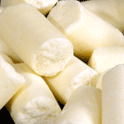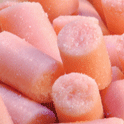|
|
In addition, chows contain plant-based compounds such as phytoestrogens which have been shown to reduce the degree of weight gain (4). For these reasons, a low-fat purified diet containing the same ingredients with a closely matched composition to the high-fat formula should be used as a control diet.
Cafeteria Diets
In the early days of rodent diet-induced obesity research, some scientists used what is known as the cafeteria diet. In this model, the animal self-selects from highly palatable, readily available foods including cookies, candy, cheese, and processed meats. These foods contain a substantial amount of salt, sugar, and fat and are meant to simulate the human Western diet. However, the nutritive and non nutritive components of these foods are not well defined. In addition, the animal may choose a different selection of foods each day. Therefore, these diets cannot be accurately replicated for future studies, which makes this type of diet a poor choice for scientific research (5).
Calories from Fat
High-fat diets used in laboratory research typically contain about 32 to 60% of calories from fat. From a nutritional perspective, a human diet of 60 kcal% fat would be considered extreme. That said, diets with 60 kcal% fat are commonly used to induce obesity in rodents since animals tend to gain more weight more quickly (6, 7) thereby allowing researchers to screen their compounds after a shorter period of time. It should also be noted that when studying the effects of a drug, nutraceutical, or gene mutation on obesity, it may be more difficult to prevent or reverse the effects of a very high-fat diet, when it might be possible with a diet containing a lower percentage of fat.
Type of Fat
The type of fat should be considered when choosing a high-fat diet for an animal study. Many high-fat diets used in laboratory animal research contain more saturated fat such as lard, beef tallow, or coconut oil and these diets are quite capable of inducing obesity in susceptible strains. In contrast, omega-3 fatty acids have been studied for their health benefits. For example, it has been shown that of animals fed similar amounts of fat, those fed diets containing fish oil did not gain as much weight as those fed diets with more saturated fat (8, 9) and were more insulin sensitive (10). Since fatty acids can affect phenotype through a variety of mechanisms (gene expression, eiconsanoid production, membrane receptor function), it is important to include information about the type and level of fat used in a study in order to allow other researchers to compare data.
Animal Models
While most rodents tend to become obese on high-fat diets, there can be variable responses in weight gain, glucose tolerance, insulin resistance, triglycerides and other parameters depending on the strain. Some inbred strains are more susceptible to obesity when fed high-fat diets such as the C57Bl6 or AKR mouse (11). However, strains that exhibit similar levels of weight gain may show different responses to other parameters. For example, when fed a 58 kcal% fat diet, C57Bl6 mice and AKR mice will have similar degrees of weight gain, but C57Bl6 mice are more glucose intolerant compared to AKR mice (11). Other strains are simply more resistant to obesity, such as the SWR/J and A/J mice (12, 13). Even within the same strain, different phenotypical responses to high fat diets have been observed between animals bred in different facilities (14).
Rat models including outbred Sprague- Dawley and Wistar rats are popular strains to study obesity as they readily gain weight on high-fat diets. In particular, Sprague-Dawley rats have been studied for their ability to show a variable response to a high-fat diet (32 or 45 kcal% fat). Some animals rapidly gain weight while others gain only as much weight as those fed a low-fat diet (15, 16), allowing for the study of animals that are prone and resistant to obesity. These animals have been selectively bred over time to study the genetic traits of animals with the obese or lean phenotype. Another strain, the F344xBrown Norway rat, has been used as a model for age-related onset of obesity since the animals gain weight until about 30 months of age (17). When this strain was fed a diet containing 60 kcal% fat, 3 month old rats separated into resistant and obese groups. This was in contrast to 24-month-old animals which had similar levels of weight gain and did not require separation (18).
There has been a growing body of literature using rodents as models of human obesity, even though there are many confounding factors including species, strain, age of the animals, type of diet, level of fat, and type of control diet. Fortunately, there is a growing discussion about these issues which will help scientists design studies with tightly controlled conditions and therefore improve our understanding of obesity and related diseases.
Reference List 1. Buettner R., Scholmerich J. and Bollheimer L.C. High-fat diets: modeling the metabolic disorders of human obesity in rodents. Obesity (Silver Spring) 15: 798-808, 2007.
2. van Heek M, Compton D.S., France CF, Tedesco RP, Fawzi AB, Graziano MP, Sybertz EJ, Strader CD and Davis HR, Jr. Diet-induced obese mice develop peripheral, but not central, resistance to leptin. J Clin Invest 99: 385-390, 1997.
3. Warden C.H. and Fisler J.S. Comparisons of diets used in animal models of high-fat feeding. Cell Metab 7: 277, 2008.
4. Cederroth C.R., Vinciguerra M., Kuhne F., Madani R., Doerge D.R., Visser T.J., Foti M., Rohner-Jeanrenaud F., Vassalli J.D. and Nef S. A phytoestrogen-rich diet increases energy expenditure and decreases adiposity in mice. Environ Health Perspect 115: 1467-1473, 2007.
5. Moore BJ. The cafeteria diet--an inappropriate tool for studies of thermogenesis. J Nutr 117: 227-231, 1987.
6. Ghibaudi L, Cook J, Farley C, van Heek M and Hwa JJ. Fat intake affects adiposity, comorbidity factors, and energy metabolism of sprague-dawley rats. Obes Res 10: 956-963, 2002.
7. Johnston S.L., Souter D.M., Tolkamp B.J., Gordon I.J., Illius A.W., Kyriazakis I. and Speakman J.R. Intake compensates for resting metabolic rate variation in female C57BL/6J mice fed high-fat diets. Obesity (Silver Spring) 15: 600-606, 2007.
8. Ikemoto S, Takahashi M, Tsunoda N, Maruyama K, Itakura H and Ezaki O. High-fat diet-induced hyperglycemia and obesity in mice: differential effects of dietary oils. Metabolism 45: 1539-1546, 1996.
9. Wang H, Storlien LH and Huang XF. Effects of dietary fat types on body fatness, leptin, and ARC leptin receptor, NPY, and AgRP mRNA expression. Am J Physiol Endocrinol Metab 282: E1352-E1359, 2002.
10. Buettner R, Parhofer KG, Woenckhaus M, Wrede CE, Kunz-Schughart LA, Scholmerich J and Bollheimer LC. Defining high-fat-diet rat models: metabolic and molecular effects of different fat types. J Mol Endocrinol 36: 485-501, 2006.
11. Rossmeisl M, Rim JS, Koza RA and Kozak LP. Variation in type 2 diabetes--related traits in mouse strains susceptible to diet-induced obesity. Diabetes 52: 1958-1966, 2003.
12. Surwit RS, Feinglos MN, Rodin J, Sutherland A, Petro AE, Opara EC, Kuhn CM and Rebuffe-Scrive M. Differential effects of fat and sucrose on the development of obesity and diabetes in C57BL/6J and A/J mice. Metabolism 44: 645-651, 1995.
13. Prpic V, Watson PM, Frampton IC, Sabol MA, Jezek GE and Gettys TW. Adaptive changes in adipocyte gene expression differ in AKR/J and SWR/J mice during diet-induced obesity. J Nutr 132: 3325-3332, 2002.
14. Pecoraro N., Ginsberg A.B., Warne J.P., Gomez F., la Fleur S.E. and Dallman M.F. Diverse basal and stress-related phenotypes of Sprague Dawley rats from three vendors. Physiol Behav 89: 598-610, 2006.
15. Levin BE, Dunn-Meynell AA, Balkan B and Keesey RE. Selective breeding for diet-induced obesity and resistance in Sprague-Dawley rats. Am J Physiol 273: R725-R730, 1997.
16. Farley C, Cook JA, Spar BD, Austin TM and Kowalski TJ. Meal pattern analysis of diet-induced obesity in susceptible and resistant rats. Obes Res 11: 845-851, 2003.
17. Scarpace P.J., Matheny M., Moore R.L. and Tumer N. Impaired leptin responsiveness in aged rats. Diabetes 49: 431-435, 2000.
18. Judge MK, Zhang J, Tumer N, Carter C, Daniels MJ and Scarpace PJ. Prolonged hyperphagia with high-fat feeding contributes to exacerbated weight gain in rats with adult-onset obesity. Am J Physiol Regul Integr Comp Physiol 295: R773-R780, 2008.
|







